Intuitive Coloring – Examples and Thoughts
This week, I show sneak peeks and process pics of simple intuitive colorings and talk about intuitive art.
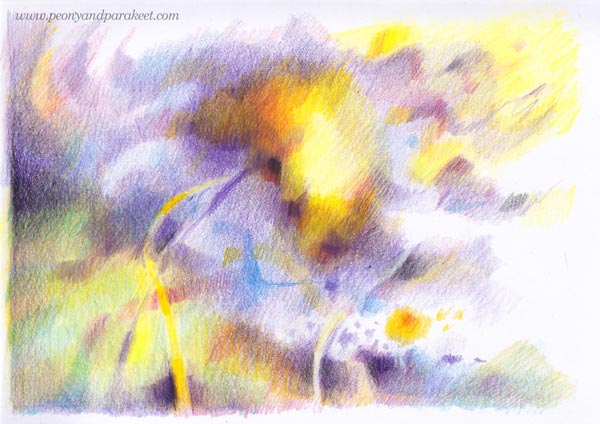
Since I made the last free video “Colored Pencils – Intuitive Approach,” I have been thinking about free coloring. First, it felt like I have explored it thoroughly in the e-book Coloring Freely and in the class Inspirational Drawing. But as soon as I began to make some notes about intuitive coloring, I realized that there are things that I haven’t shared in these blog posts or in my classes so far. Many of them are things that seemed complicated and heavy at first, but the more I have experimented with them, they appear to be very simple and light.
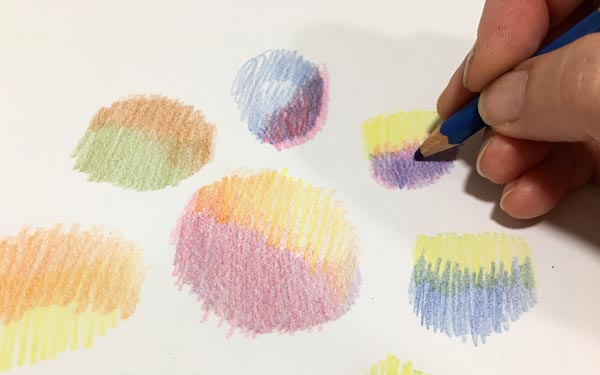
And it feels fun to color freely on a blank paper, and there’s a sense of playfulness too right from the beginning.
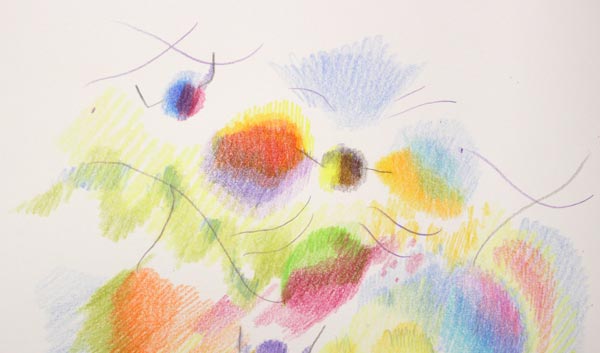
I am a more-is-more kind of a person, but after making a series of large oil paintings, I wrote a mental note that says “less is enough” in capital letters.
Can Intuitive Coloring Be Taught and Learned?
I have also been thinking about the term “intuition” a lot. Why does it feel so intuitively correct to say that my art is intuitive? And not only that. Why do I want to teach intuitive art? Because isn’t intuitive just about letting go and emptying the mind on paper? Doing what you want, doing what feels right?
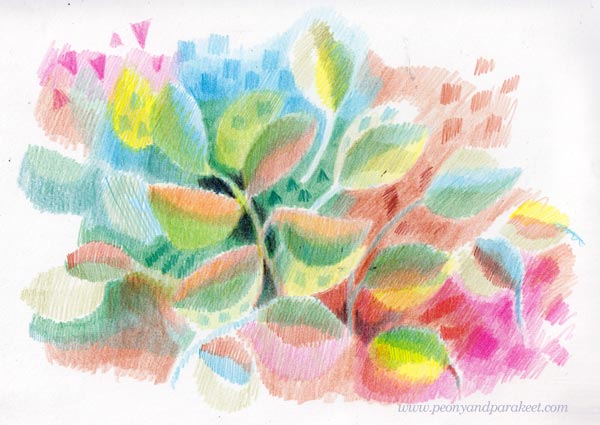
But as a former engineer, it’s always been hard for me to trust intuition when I am trying something new or reaching for a new level. Then the intuition is confused with the comfortable “same-old-same-old” routine. That old dog always stays close, but intuition and imagination are timid puppies. To find the puppies – that’s where I feel I can help.
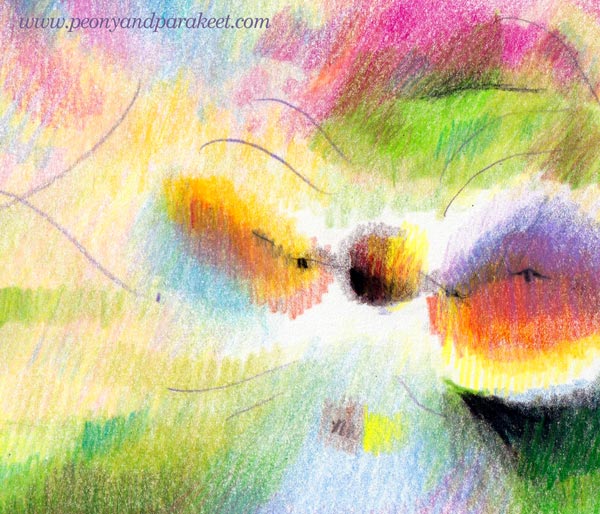
Would you be interested in this upcoming class?
All In – Finding Uncommon Inspiration
This week, I share my biggest painting so far, and talk about computer games and all the things that should not inspire but that do!
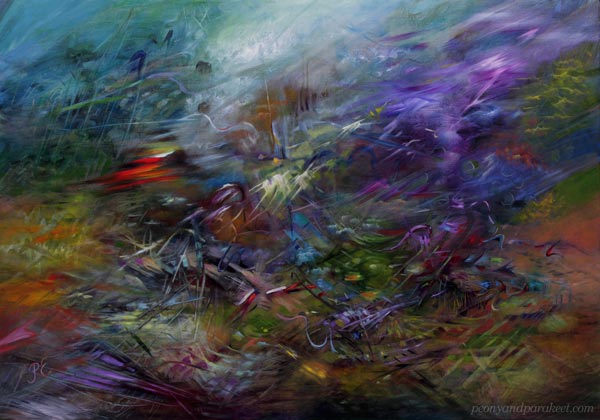
Here’s the last painting of the series that I have been working on this year. It’s called “All In.” The Finnish translation “Kaikki peliin” is perhaps even more suitable because there’s the word “peli” – the game. In this painting, I made every element look like it moves – like in a computer game!
I Am Not a Gamer
No, I am not! Actually, I am the last person who should be talking about computer games because I don’t play them at all. But I have seen some commercials on television and Youtube, and they make my heart beat faster – that’s the tribe where I belong! Despite I hate seeing violence, and don’t usually even watch action movies. Action upsets me. In general, I prefer everything cute and pretty.
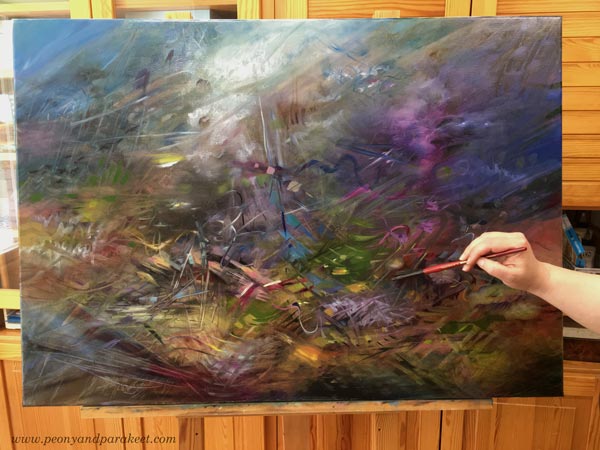
My Imagination Loves Games
But when I paint, I am not just an artist with all kinds of brushes and tubes. I become a nerd who tries to find the fastest processor and the best graphics driver for rendering 3D from her brain. It no longer matters what kind of art I should create and how art should be created. I change to a guy who moves from one level to the next, always seeking more monsters, more excitement, more points.
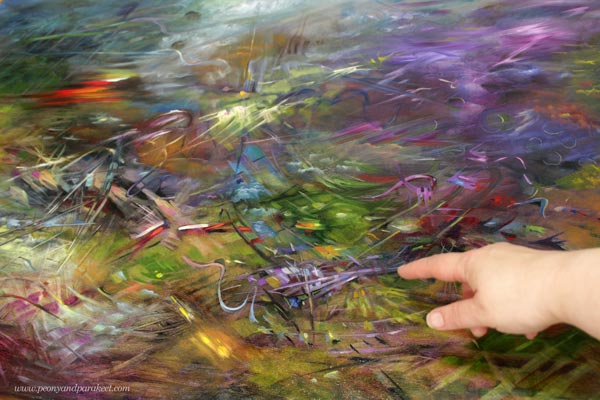
Because I don’t play the games, I should not even know how it is like. Yet, I feel I do. Namely, in my twenties, I chose computers over art. I felt I belonged to the world of introverts who built systems – worlds of their own. And now, when I paint, my paintings bring me back to the same setting – how to build a world that operates like a fast-moving game, with many layers and levels.
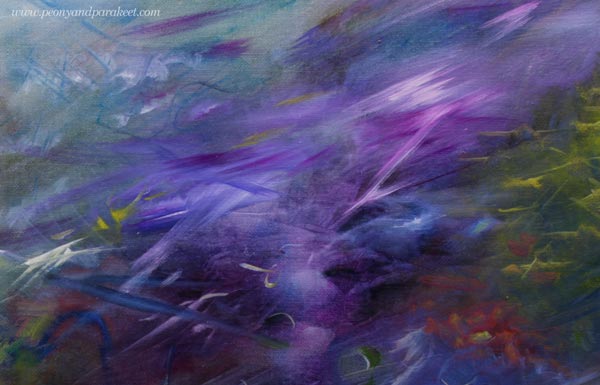
This is not what I would have expected. If someone said to me: “Hey Paivi, you should paint game sceneries. Make your own games!” I am pretty certain that a couple of years ago my answer would have been: “You must be kidding. I am a feminine romantic who hates that stuff!”
The Adventure for Uncommon Inspiration
But art is an adventure. It’s not only a journey to a variety of techniques and skills but also an exploration that includes the darkest corners of your mind.
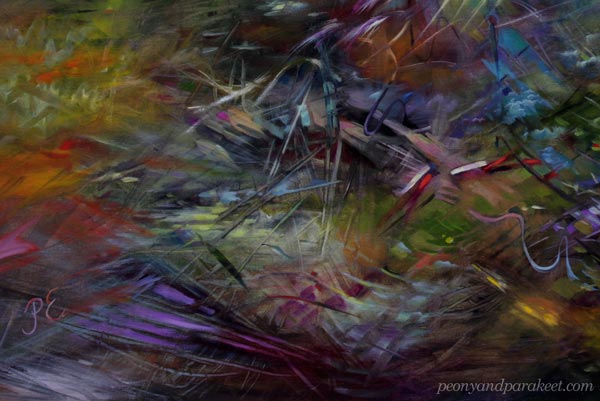
In 1980s, I was a girl who sat in a local library on hot summer days, browsing big books of old art. My dream was to become an artist, but knowing that it would not be safe or easy, I said I wanted to be an English teacher. Between the art books of the library, I saw young boys browsing computer magazines. I went to the shelf after them and knew that I also belonged there – to that group of nerds. And when I saw a computer for the first time, my heart beat fast like for the best painting of a museum.
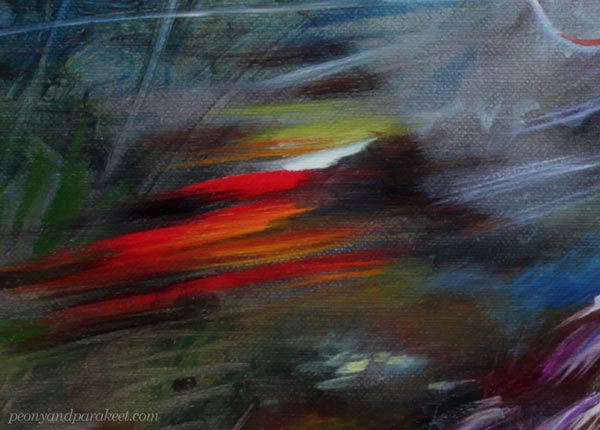
Making a series of paintings has been quiet and hard work. I have had lots of self-doubts and melancholic moments between the sessions. But when I paint, it’s all good. My paintings say: “Tell me what you want and we will give it to you!” And often, I don’t know what to reply, but they seem to know anyway. Like I never told them how nerd I am, but they shamelessly reveal everything and apologize for nothing.
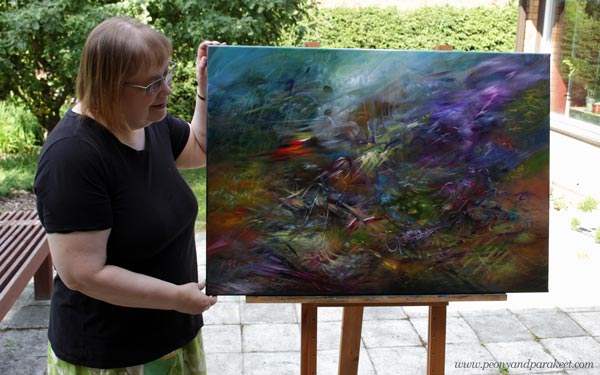
We talk a lot about being unique as artists, but what about if a part of the solution is just to find inspiration that feels uncommon to us. It could be something that we try to get rid of but never seem to manage to do. Or something that we find appalling but still strangely captivating.
What could be your uncommon inspiration? Could the art that you create be a little different from the art that you like to consume? What do you think?
Artist’s Life – What’s Boring and What’s Not!
This week, I make a watercolor painting and talk about how artist’s life can seem different than what it is.
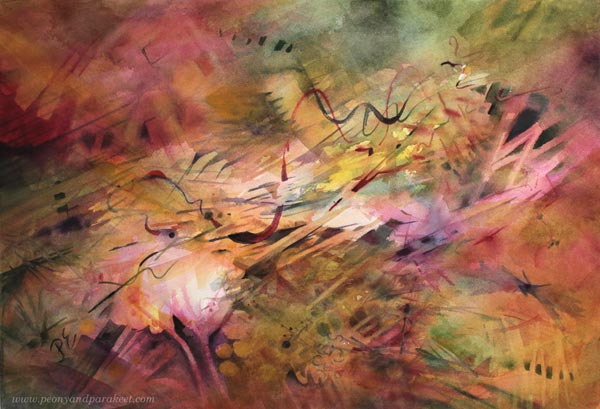
Let’s turn back time and see how this painting came to life!
Is the Art Understood – A Story about Hilma af Klint
It’s a hot summer day, and watercolors are calling me. So I wet a paper, and after the water has soaked in, I start painting with a big brush.
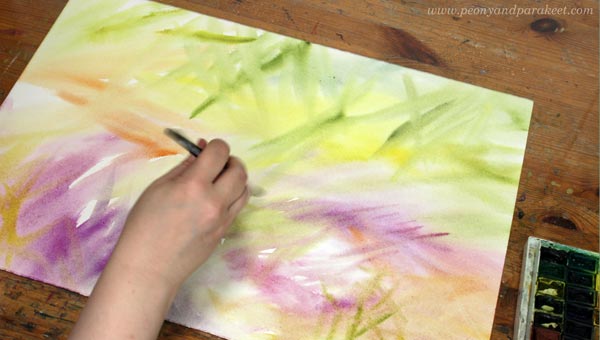
The paper is Fabriano Artistico (cold press). I buy watercolor paper in big sheets and split them in half.
With the first strokes, I listen to the last minutes of an audiobook that has kept me company for a few weeks. It’s “Hilma af Klintin arvoitus” (The mystery of Hilma af Klint) by Pirkko Kotirinta. It’s a new book, published this year and currently only available in Finnish.
Even if the book is about Hilma af Klint (1862-1944), an interesting Swedish abstract pioneer, the companionship with the book hasn’t been pleasant. Mostly because I wanted to know about Hilma’s thoughts and philosophies – her inner life. But the book focuses on the external events and on the author’s background investigation for those.
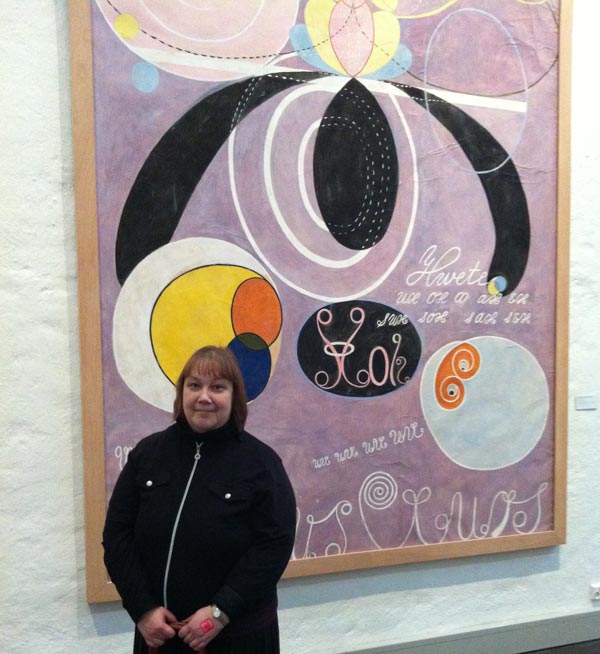
When the book ends, I think about how people who admire artists from the outside perspective often romanticize things that are not romantic at all. There has been a lot of them around Hilma too. These people say: “The artist chose not to sell her art” or “The artist wanted to keep her art private,” but honestly, no professional artist wants that.
Instead, it can happen as it did for Hilma, that despite all the effort, the art was not respected or understood, and that breaks the artist’s heart. Hilma af Klint decided that the time would be more suitable later. So, she stated that her work had to be kept secret for 20 years after death.
Every artist wants to be current, but art has its own timeline. Sometimes it’s too far in the past, and sometimes – like Hilma’s – in the future. Painting freely is like a game where every layer is a new level. The result is unexpected, yet synchronized with the inner clock of the artist.
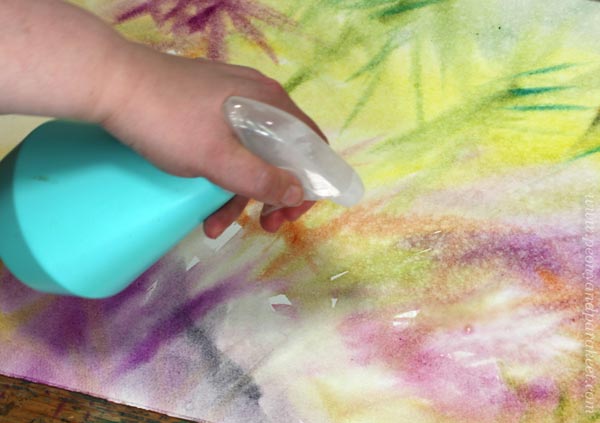
Boring and Not – Two Sides of Artist’s Life
People who look at artists from the outside perspective think that they live a carefree and eventful life. Therefore, they try to solve the mystery of Hilma af Klint by tracking the external events instead of internal ones. Artist’s handwritten diaries can be too confused, and it’s less complicated to travel from town to town and follow the actual footsteps. But most of Hilma’s life was spiritual, and her 193 gigantic temple paintings, laborious to create.
From the external perspective, art-making is one of the most boring things if you measure it by the amount of silence and concentration.
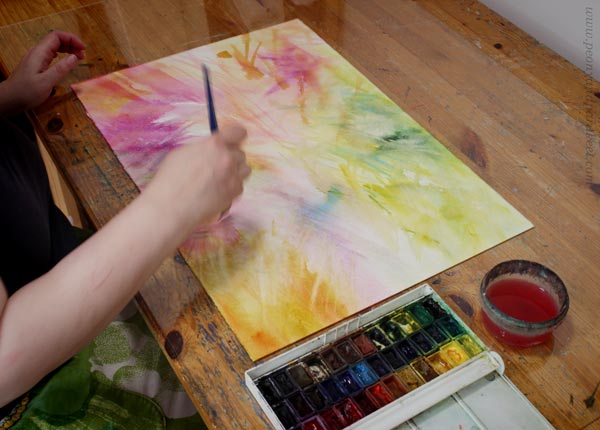
Here I am working with a flat brush.
However, what happens in the inner world, can make the artist’s life most exciting. We get to fly to a new land, find a color, be a color! We get to transmit a spirit through shapes and their interaction.
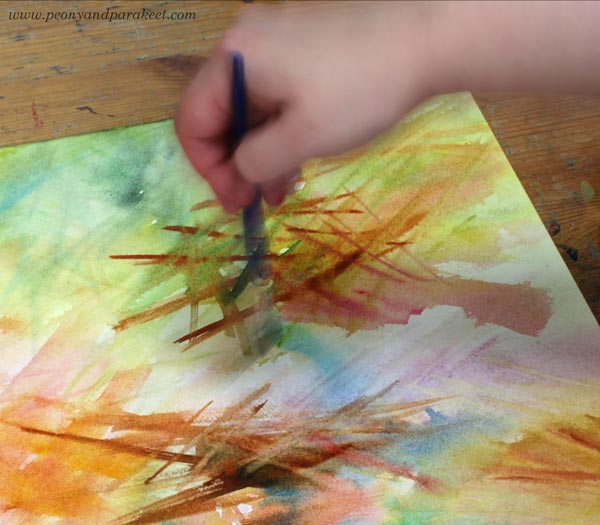
At first, accidental spots of color cause traditional associations: “Here could be a leaf, there a flower.” But when we let them go, a more personal layer opens: “Here’s something that reminds me of teenage years.” And slowly, more layers unfold, colors give room to shapes, and something that first sounded like a foreign language reaches the natural rhythm, and everything falls in place.
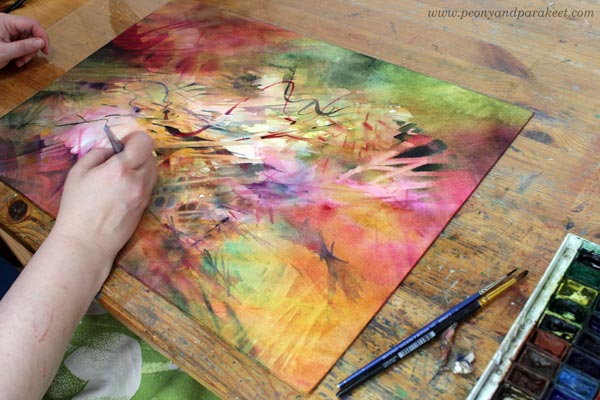
Negative painting – painting around the shapes – brings out light elements.
I work from light to dark and slowly add depth. The process of moving from traditional to natural is the toughest one for me. It requires to face many unpleasant memories – mental monsters that guard the paradise. From the outside perspective, I only make slow strokes for hours. But inside, I am crossing a storming sea feeling afraid of failure and success at the same time. The monsters are roaring on both shores and the only way to get through is not to beat but tame them.
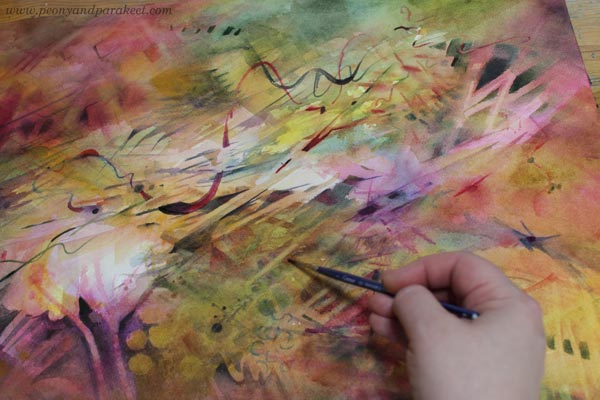
This painting took two days and several sessions.
The monsters are often visible in my paintings too. People often point them when choosing their favorite details: “I like this. How did you do that?”
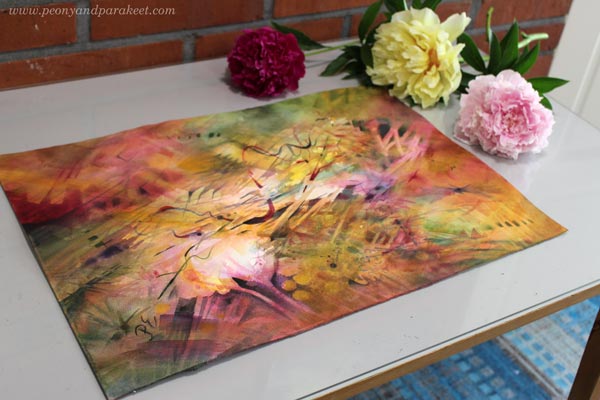
The two sides of art – the technical and the spiritual – are always present. Thus, art is always about both learning the strokes and living the strokes.
Paivi’s Watercolor Classes & Exhibitions
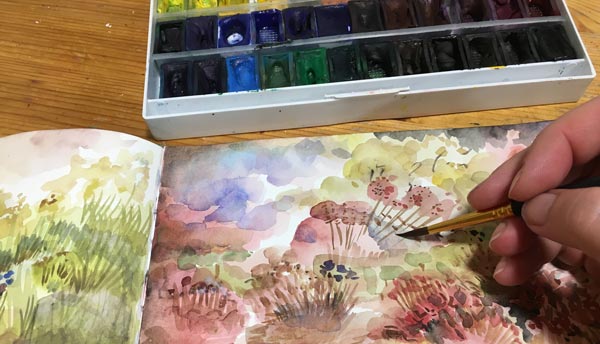
No matter what media you end up loving, watercolors have a lot to teach! Color washes, the negative painting technique, making simple shapes more elegant – all these techniques are useful for any art. Paivi likes to think about her watercolor set as a little assistant, always eager to work, and someone who sets her back on track.
- Watercolor Journey – outer and inner sceneries
- Floral Fantasies – loose and layered bouquets
- Magical Forest – intuitive watercolor painting
If you are in Italy or Finland, come to see Paivi’s watercolor paintings! “Shyeling” is displayed in the international group exhibition in Fabriano from June 20 to Oct 31. “Torchbearer” and “Maximalist” are displayed in the Akvart gallery in Helsinki from July 12-25, 2021.
Also check: Original watercolor paintings available in the shop
Mystical Side of Art(ist) in Progress
This week, I show an unfinished painting and talk about the mystical side of nature and art.
I have a big painting in progress. At least it’s the biggest one that I have ever made – 92 x 65 cm, about 36 x 26 inches. It’s an oil painting, and it takes time because it needs to dry between the sessions. The pics you see here are from the third session, and there’s at least one, maybe even two, to go. But this is the last piece of the series, so I don’t want to rush. The painting needs time to mature, and I want to end the series gloriously.
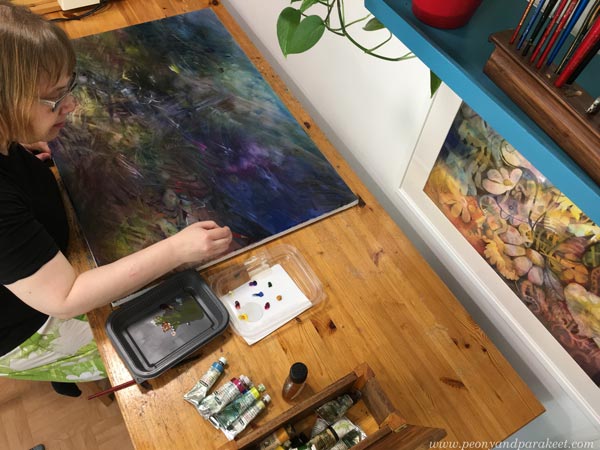
I don’t usually post about a piece that I haven’t finished yet. It’s like presenting an uneducated child that doesn’t quite know how to behave. But the more perfectly my art has aligned with my personality, the more I have started to embrace imperfection. My art will always be imperfect because I am imperfect. Life is imperfect.
Rational or Mystical?
My education in software engineering has shaped my beliefs about life for tens of years. But recently, I have had experiences that feel less scientific and more mystical.
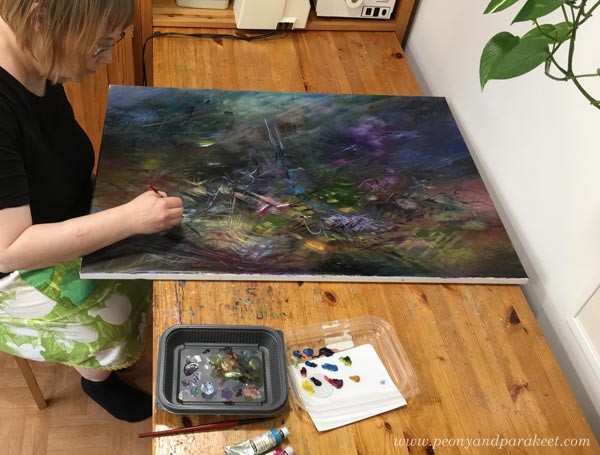
My paintings seem to know how they want to grow, and my ego disappears.
One Mystical Morning
One morning, when I was walking the dog, I saw a miraculous view. It was meant to be just an experiment. I asked myself to look at nature like I would look at a painting in progress. And suddenly, I saw everything in a new order – not organized by a hierarchy or by their aesthetic value. Gravel, weed, grass, dandelions, trees – all were equal and formed one mysterious mesh.
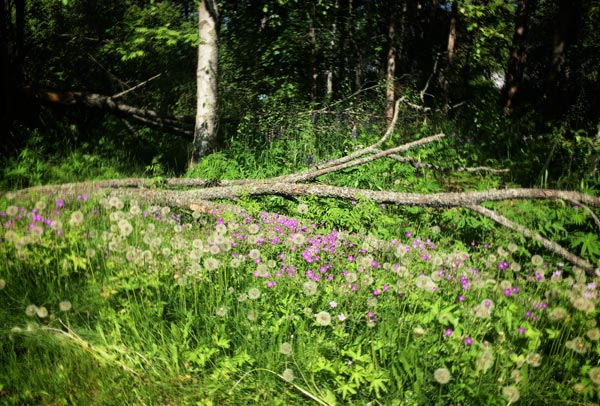
I was part of that mesh too. Not any more valuable than a crooked stem of a dandelion, but still tremendously happy and free.
Every Stroke is a Weed – For How Long Can It Grow?
We art instructors talk often about visual hierarchy – there’s a lot of that in my classes too! The image needs a focal point, and there needs to be a visual flow in a composition. Otherwise, the image looks stiff and the viewer is left puzzled. But the more I have painted, the more I have postponed all that visual organization. That’s why you see me working on the table mostly, focusing on the details.
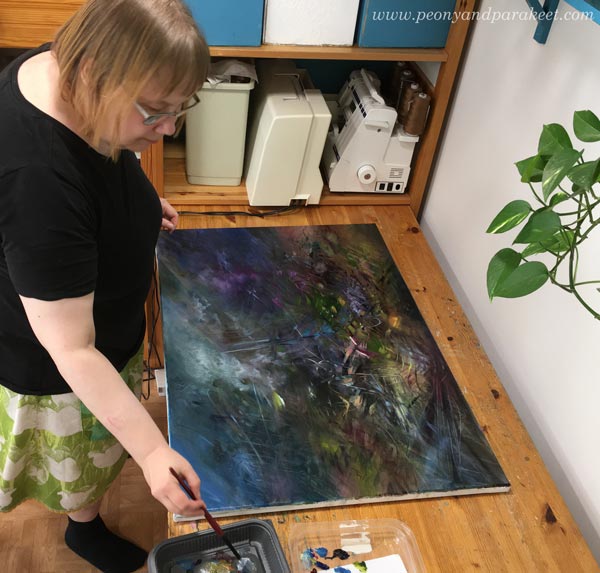
When the painting is in progress, it grows all kinds of weeds, and it’s ok. Then, when I am close to an end, I will put the painting on the easel and improve the visual hierarchy and flow.
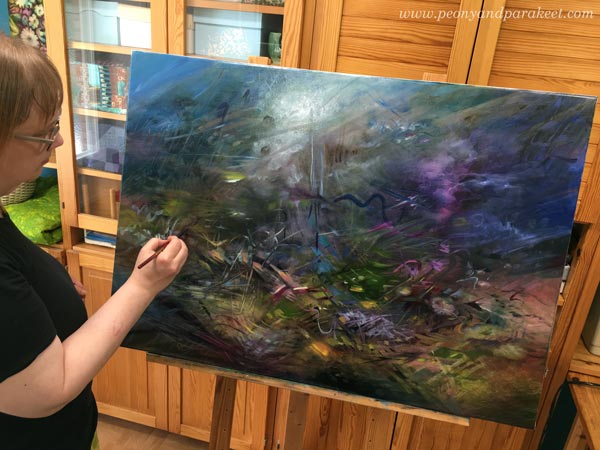
So, I let the child play freely first before teaching it to greet, bend the knees a bit, and make the viewer feel welcome. Before the last part, I can just enjoy the mesh and let the artist be one with the child.

What do you think? Does this make sense to you? Have you had mystical experiences?